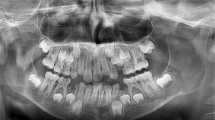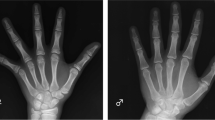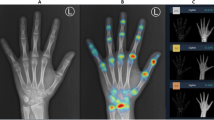Abstract
This study assesses the value of the Greulich and Pyle method in determining the skeletal ages of healthy American children of European and African descent born after the year 1980. The hand and wrist radiographs of 534 children (265 boys, 269 girls; 260 European-Americans [EA], 274 African-Americans [AA]), ages 0 to 19 y, were analyzed by two experienced pediatric radiologists blinded to the chronological age of the subjects. A difference score was calculated for each subject by subtracting chronological age from the mean bone ages scores provided by the two raters. One group t-tests were performed to verify the hypothesis that the mean difference score was equal to zero. Skeletal age determinations by the two radiologists showed a high degree of agreement by intraclass correlation coefficient (r = 0.994). The range of values for differences in skeletal and chronological ages was very wide, indicating great individual variability. Comparisons between skeletal and chronological age only reached statistical significance in EA prepubertal girls, whose skeletal ages were delayed, on average, by three months (t = −2.9;p = 0.005). Mean difference between skeletal and chronological age in prepubertal children of African descent was 0.09 ± 0.66 y, while that in children of European descent was −0.17 ± 0.67 y; (t = 3.13;p = 0.0019). On average, the bone ages of 10% of all prepubertal AA children were 2 SD above the normative data in the Greulich and Pyle atlas, while the bone ages of 8% of all prepubertal EA children were 2 SD below. In contrast to the racial differences observed in prepubertal children, EA postpubertal males had significantly greater values for bone age than AA postpubertal males (t = 2.03;p = 0.05). In conclusion, variations in skeletal maturation in prepubertal children are greater than those reflected in the Greulich and Pyle atlas; prepubertal American children of European descent have significantly delayed skeletal maturation when compared with those of African descent; and, postpubertal EA males have significantly advanced skeletal maturation when compared with postpubertal AA males. New standards are needed to make clinical decisions that require reliable bone ages and to accurately represent a multiethnic pediatric population.
Similar content being viewed by others
Log in or create a free account to read this content
Gain free access to this article, as well as selected content from this journal and more on nature.com
or
Abbreviations
- AA:
-
African-Americans
- EA:
-
European-Americans
- ICC:
-
intraclass correlation coefficient
- SD:
-
standard deviation
References
Tanner JM, Whitehouse RH, Marshall WA 1975 Assessment of Skeletal Maturity and Prediction of Adult Height (TW2 Method). Academic Press, New York
Greulich WW, Pyle SI 1959 Radiographic Atlas of Skeletal Development of the Hand and Wrist. 2nd ed. Stanford University Press, Stanford, CA
Groell R, Lindbichler F, Riepl T, Gherra L, Roposch A, Fotter R 1999 The reliability of bone age determination in central European children using the Greulich and Pyle method. Br J Radiol 72: 461–464
Cole AJL, Webb L, Cole TJ 1988 Bone age estimation: a comparison of methods. Br J Radiol 61: 683–686
Garn SM, Sandusky ST, Nagy JM, McCann MB 1972 Advanced skeletal development in low-income negro children. J Pediatr 80: 965–969
Marshall WA, Ashcroft MT, Bryan G 1970 Skeletal maturation of the hand and wrist in Jamaican children. Hum Biol 42: 421–435
MacKay DH 1952 Skeletal maturation in the hand: a study of development in East African children. Trans R Soc Trop Med Hyg 46: 135–150
Ontell FK, Ivanovic M, Ablin DS, Barlow TW 1996 Bone age in children of diverse ethnicity. Am J Roentenol 167: 1395–1398
Loder RT, Estle DT, Morrison K, Eggleston D, Fish DN, Greenfield ML, Guire KE 1993 Applicability of the Greulich and Pyle skeletal age standards to black and white children of today. Am J Dis Child 147: 1329–1333
Karlberg P, Taranger J 1976 The somatic development of children in a Swedish urban community. Acta Paediatr Scand Suppl 258: 1–148
Behrman RE, Vaughan VC III, Nelson WE 1987 Textbook of Pediatrics. 13th ed. WB Saunders Co., Philadelphia, 1185–1186.
Tanner JM 1978 Physical growth and development. In: Forfar JO, Arnell CC (eds) Textbook of Pediatrics. 2nd ed. Churchill Livingstone, Edinburgh, 249–303.
Hamill PVV, Drizd TA, Johnson CL, Reed RB, Roche AF, Moore WM 1979 Physical growth: national center for health statistics percentiles. Am J Clin Nutr 32: 607–629
VaughanIII VC, Litt IF 1987 Developmental pediatrics: assessment of growth and development. In: Behrman RE, VaughanIII VC (eds) Nelson Textbook of Pediatrics. 13th ed. WB Saunders, Philadelphia, 24–33.
Bartko JJ 1966 The intraclass correlation coefficient as a measure of reliability. Psychol Rep 19: 3–11
Poznanski AK 1984 The Hand in Radiologic Diagnosis with Gamuts and Pattern Profiles. 2nd ed. WB Saunders, Philadelphia
Johnson GF, Dorst JP, Kuhn JP, Roche AF, Davila GH 1973 Reliability of skeletal age assessments. Am J Roentgenol 118: 320–327
Kemperdick HF 1981 Determination of skeletal age in children of Western Germany with normal and abnormal growth development. Fortschr Med 99: 152–156
King DG, Steventon DM, O'Sullivan MP, Cook AM, Hornsby VP, Jefferson IG, King PR 1994 Reproducibility of bone ages when performed by radiology registrars: an audit of Tanner and Whitehouse II versus Greulich and Pyle methods. Br J Radiol 67: 848–851
Gross GW, Boone JM, Bishop DM 1995 Pediatric skeletal age: determination with neural networks. Radiology 195: 689–695
Roche AF 1979 Skeletal maturity of youths 12–17 years: racial geographic area, and socioeconomic differentials, U.S. 1966–70. U.S. Dept. of Health, Education, and Welfare, Washington, DC, Publication 79-1654(11): 167
Acknowledgements
The authors would like to thank Mrs. Cara Beck for her technical assistance and comments on this manuscript.
Author information
Authors and Affiliations
Corresponding author
Additional information
Supported in part by a grant (1RO1 LM06270) from the National Library of Medicine.Present Address [S.M.]: Department of Pediatrics, Scientific Institute H San Raffaele, Milan, Italy.
Rights and permissions
About this article
Cite this article
Mora, S., Boechat, M., Pietka, E. et al. Skeletal Age Determinations in Children of European and African Descent: Applicability of the Greulich and Pyle Standards. Pediatr Res 50, 624–628 (2001). https://doi.org/10.1203/00006450-200111000-00015
Received:
Accepted:
Issue date:
DOI: https://doi.org/10.1203/00006450-200111000-00015
This article is cited by
-
Greulich and Pyle atlas: a non-reliable skeletal maturity assessment method in the North Indian population
Forensic Science, Medicine and Pathology (2023)
-
Forensic age prediction and age classification for critical age thresholds via 3.0T magnetic resonance imaging of the knee in the Chinese Han population
International Journal of Legal Medicine (2022)
-
Tanner–Whitehouse skeletal maturity score derived from ultrasound images to evaluate bone age
European Radiology (2022)
-
Clinical, laboratory and radiological assessment of skeletal maturation in children and adolescents with obesity
Egyptian Pediatric Association Gazette (2020)
-
Is the Greulich and Pyle atlas applicable to all ethnicities? A systematic review and meta-analysis
European Radiology (2019)



